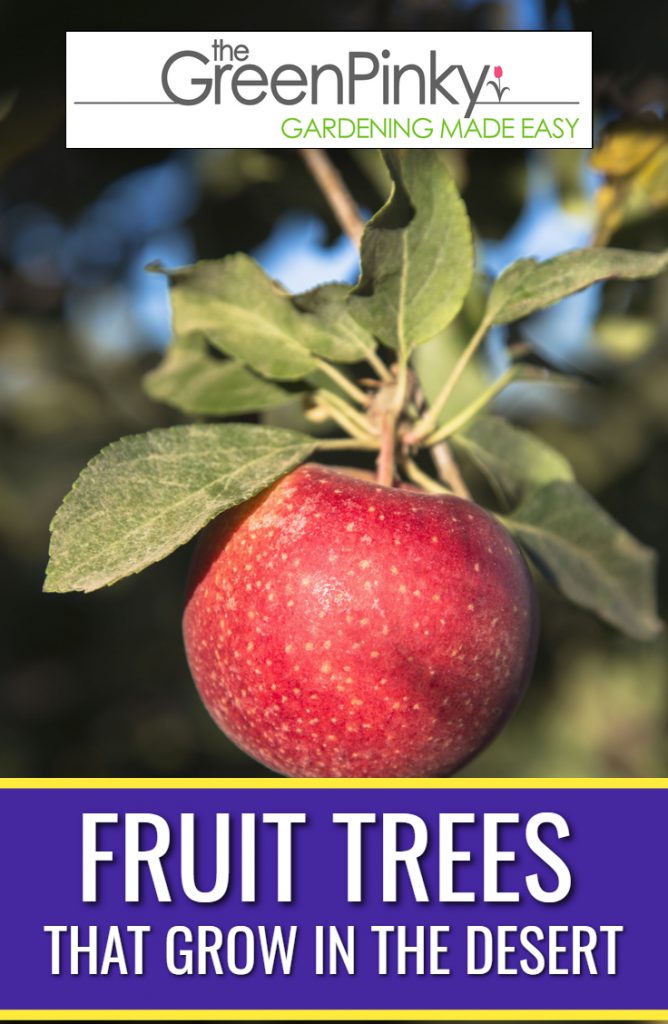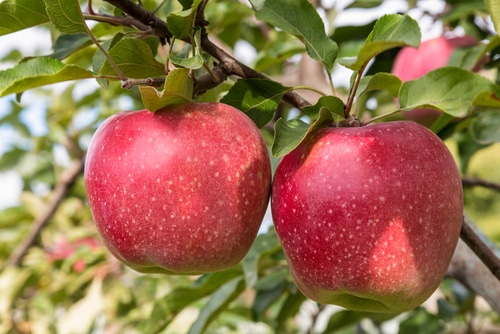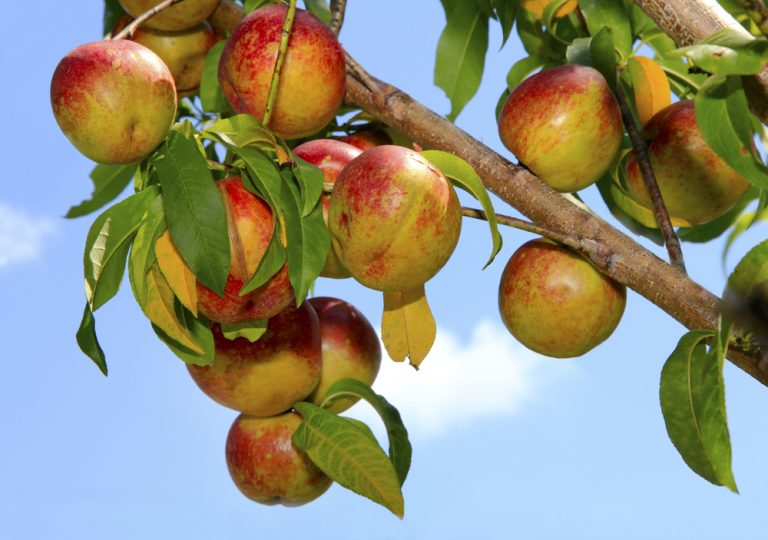Those living in desert climates have a wealth of trees that thrive in the environmental conditions. But how great would it be to have one that you can go outside in the morning and just pluck a delicious fruit off of and eat straight away?
When choosing a fruit tree, it’s best to select one with low-chill requirements and produce fruit that ripen before summer’s extreme temperatures. Regardless of the type, appropriate care and ideal growing conditions will result in the best growth and harvests.
Continue reading below to find some of the fruit trees that we recommend for your desert garden.

Plum Trees (Prunus spp.)
Plum trees have a low-chill requirement that allow them to thrive in desert climates. The are attractive deciduous trees that don’t grow too large, usually averaging around 10 to 20 feet tall. In the spring, it bursts into bloom with its canopy filling with flowers. The juicy and tasty plums it yields follow after the flowers.
They prefer a sunny location with well-drained soil. Although they can grow in hot climates, they are not drought-tolerant and require additional water in the dry conditions. If conditions are too dry, it may suffer fruit drop.
Below are specific cultivars that will grow better in a desert landscape.
Santa Rosa
Santa Rosa is a Japanese variety that is more heat-tolerant than many plum varieties and is hardy in USDA zones 5 – 9. The Santa Rosa develops to be about 18 to 20 feet wide and tall at maturity and it takes around three years for it to start producing plums. In the spring, its canopy becomes filled with white blooms, making it quite attractive. Large red to purple plums with yellow flesh ripen in the midseason. The fruit is tasty, eaten fresh, canned, or used to cook.
Although it is self-pollinating, fruit production will be more abundant when there’s another Santa Rosa planted nearby. Irrigate regularly, especially during the flowering and fruiting stage.

Methley
Methley plum is a Japanese variety that is also suitable for desert climates. It is hardy when grown in USDA zones 5 – 9. The standard variety grows around 20 feet tall and wide and the dwarf version grows around 10 feet tall and wide. Its produces a canopy of white flowers early in the season, with plums ripening in the late spring and early summer. The vigorous growing tree is a heavy bearer producing sweet and juicy reddish-purple plums. Methley trees usually start bearing fruit in two to three seasons and the plums are good eaten fresh or used for jellies.
Methley’s are quite heat-tolerant, but it grows best when irrigated regularly. m planted nearby. Methley makes a good pollinator for other plum trees. Like most other plum varieties, the Methley grows best in well-draining soil. It is self-pollinating, but harvests will be more abundant when there is another Japanese plu
Apple Trees (Malus domestica)
Apple trees grow well in a desert climate. Not only do they tolerate hot conditions, but they also have low-chill requirements. Depending on the variety, they can grow anywhere from 15 to 25 feet tall and wide. The deciduous trees are quite showy in springtime as their canopies fill with white flowers that attract butterflies and hummingbirds. Tasty apples follow the spent flowers. Depending on the type, apples can be red, pink, yellow, green, and blushed.
For the best success, grow them in slightly acidic soils that drain well. In addition, for the best flower and fruit production, it should be planted in a location that receives full sun. Soils that tend to retain too much water and become soggy, should be avoided. For the best growth, irrigate the tree regularly to prevent blossom and fruit drop, especially when conditions are extremely hot and dry.
Listed below are some suitable cultivars that grow well in a desert region.
Ein Shemer
Originally from Israel, Ein Shemer is an excellent for a desert region like Arizona. The Ein Shemer has a low-chill requirement of 100 to 250 hours and is hardy in USDA zones 6 – 9. It’s a suitable addition for a smaller landscape as mature trees grow around 12 to 15 feet tall and wide. The springtime blooms give way to medium-sized apples that are pale yellow. Apples ripen in summer and are crisp and tart, making them delicious eaten fresh or made into applesauce.
Although self-fertile, you’ll get more productivity when another apple pollinator is planted nearby. Plant Ein Shemer in fertile soil that drains well and is located in a full sun site. For the best growth, water it regularly, especially when conditions are especially hot and dry. If you plant another type of apple tree close to the Ein Shemer, plant it around 15 to 20 feet apart for good cross-pollination. Anna makes a good pollinator for Ein Shemer.

Anna
With low-chilling requirements of only 200 hours, Anna is a good fruit tree for those in a climate with mild winters. It is hardy throughout USDA zones 6-9. Annas are deciduous and average around 20 to 25 feet tall and wide. They fill with spring blooms, making it a showy addition to a garden. The apples it produces are sweet and crisp. Anna apples ripen in early summer and can be stored for up to two months.
Similar to prior varieties, the Anna is self-pollinating but yields more apples when grown near other trees. To reduce issues with growth, blossom, and apple production, water it regularly, especially if your area is experiencing hot and dry conditions. Grow Annas in a location with fertile soil that drains well and don’t plant in a location with soggy soil. Full sun produces the best growth.
Pomegranate (Punica granatum)
Pomegranates are an example of a plant that thrives in hot areas. No room in the landscape? No problem because there are smaller cultivars well-suited for growth in a pot. Depending on the type, pomegranate plants grow anywhere from 2 to 20 feet tall and with a width of about half. Although deciduous in most of its range, in consistently warm tropical areas, it performs as an evergreen. Reddish-orange, trumpet-shaped flowers bloom in summer, followed by the leathery-skinned, globelike pomegranate that range from 2 to 4 inches in diameter. The inside of the pomegranate contains the juicy, sweet sacs containing the seeds.
For the best growth and harvest, plant the pomegranate in a sunny area with fertile soil that drains well. If growing in pots, use a rich potting mix with good drainage—only water plants when the soil becomes almost completely dry.
A few suitable cultivars are listed below.

Nana
For a true dwarf pomegranate that is perfect for small garden areas or grown in containers, Nana fits the bill. The Nana typically grow 2 to 4 feet tall and wide with thorn-lined branches. The deciduous leaves start out in spring a bronze color, changing to a bright green and add fall color changing to yellow. Everything about Nana is small, including the summer blooming smaller reddish-orange flowers and the dwarf reddish pomegranate ripening in fall.
The Nana prefers a sunny location with fertile soil that drains well. Although relatively tolerant to drought once established, it requires consistent moisture while it’s flowering in summer. If growing in containers, use a rich, well-draining potting mix. Use at least a 3-gallon container with bottom drain holes. Plants are self-pollinating.
Wonderful
A pomegranate that produces its best quality in hot inland locations, Wonderful is a great choice. It’s hardy growing throughout USDA zones 7 – 10. It grows into a large shrub with a mature height and width of about 6 to 8 feet. Large, orange-red flowers bloom in summer, followed by large red pomegranate with a juicy, tart flavor. It’s likely the pomegranate that you purchase at your local grocery store.
Grow a Wonderful pomegranate in a sunny location in fertile soil that drains well. The pomegranate produces vigorous growth and has abundant harvests, so plant it in a location where it can spread without interference. Although it’s relatively tolerant to drought once established, water regularly during flowering.
Peach Trees (Prunus persica)
Peach tree cultivars hardy growing in desert climates are bred to have low-chill hours necessary to flower and produce fruit. Additionally, they have also been bred to tolerate the heat and produce healthy growth provided they are given continued care.
The deciduous tree makes an attractive desert garden addition with their pinkish spring flowers. The flowers turn into the juicy and sweet stone fruits that are tasty eaten fresh or used in various cooking recipes. They can start producing peaches as early as three years. Depending on the particular cultivar, they grow anywhere from 8 to 20 feet tall and wide, making them suitable additions to a small space desert garden.
For the best flowering and fruiting, situate it in a location receiving full sun. The tree prefers a fertile sandy loam soil that drains well and doesn’t remain soggy.
Below are some excellent peach cultivars that are hardy in desert conditions.

Tropic Beauty
The Tropic Beauty was cultivated by the University of Florida for hardiness in hot locales. It’s hardy in USDA zones 8 through 10 with low-chill hours of 100 to 200 hours. The Tropic Beauty grows to about 15 feet tall and wide, making it a good selection for smaller gardens. In early spring and before new foliage appears, it bursts into bloom with light pink flowers. About 90 days after flowering, medium-sized, freestone peaches that are yellow with a red blush and yellow flesh are ready for harvesting.
Plant Tropic Beauty in a sunny location with well-drained fertile soil that doesn’t tend to collect water. Peach trees with wet feet won’t thrive. Irrigate it regularly, especially while it establishes itself into the new planting location. Depending on your local weather, you may have to irrigate daily, especially when conditions are hot and dry. The Tropic Beauty typically starts producing peaches two years after planting.
Flordaprince
Flordaprince is a great peach tree cultivar that is extremely hardy growing in a desert garden found in locations like Arizona. Trees are hardy growing in USDA zones 9 through 10. Developed by the University of Florida, it’s another peach that’s hardy growing in consistently warm locations. The deciduous tree grows around 15 to 18 feet tall and with a similar width. Light pink flowers bloom early in the springtime, followed by tasty peaches ready for harvest in late spring and early summer. The medium-sized, semi-freestone peaches are yellow, with 80-percent of the skin covered in a red blush.
For the best growth and production of flowers and fruit, grow Flordaprince in a location receiving full sun. It performs best in fertile soils that drain well and don’t remain soggy after rain or irrigation. When it comes to continued care, irrigate saplings regularly while they establish themselves in the planting site. You will have to irrigate daily if your weather is hot, dry, and also when the Flordaprince is flowering and producing fruit.

